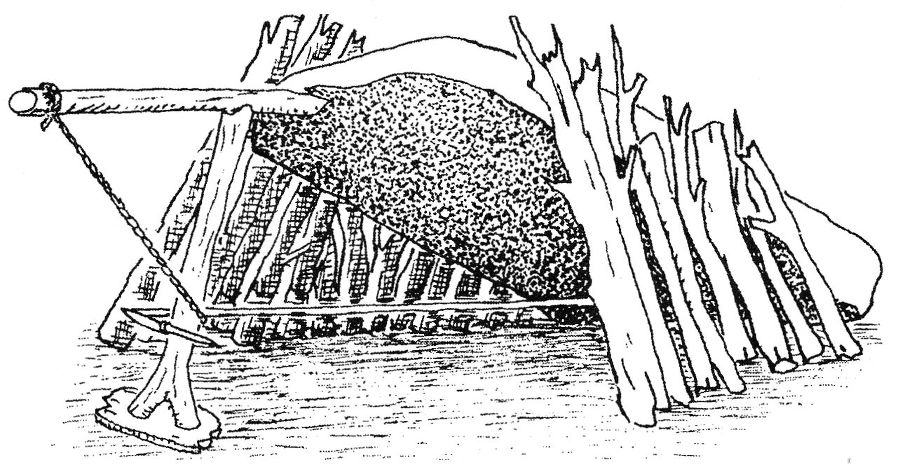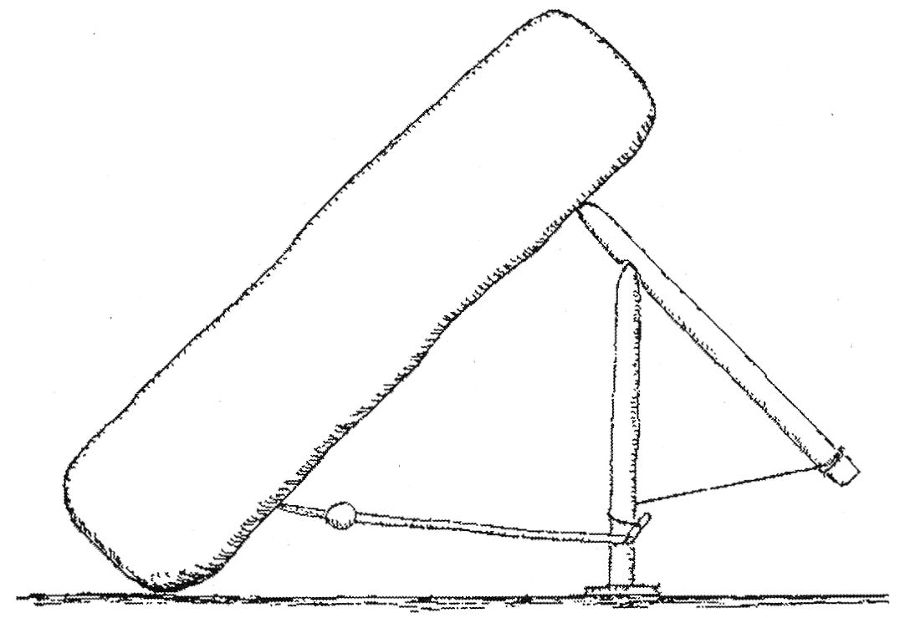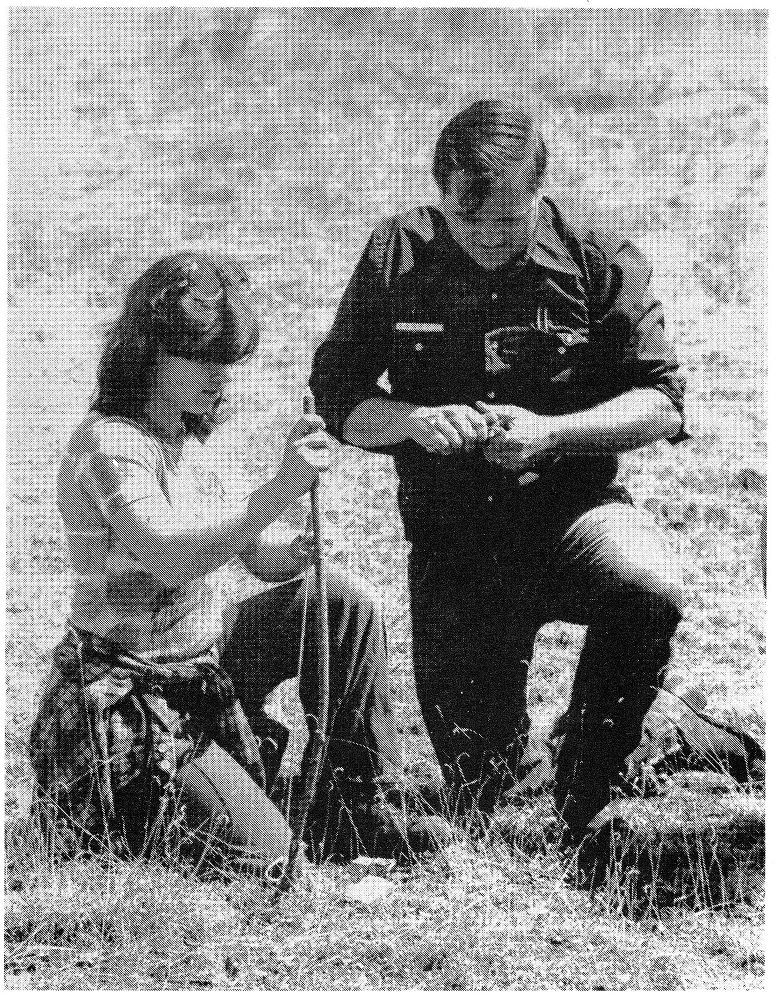Finally, by the third morning I had solidly caught that fat packrat! We feasted on three rats that day, as another participant’s deadfall was successful and I had caught a second rat in a pole snare actually set for a chickaree (red squirrel). End of tale.
While my information is definitely not exhaustive, for some this may be more than you ever cared to read about the Paiute deadfall! Hopefully for others it will stimulate field application or even research into the physics of weight distribution throughout the trigger components. Except where otherwise credited, this article is presented as my own opinion, assessment and experience. To each his own. Me? Really, I’m glad I know how to catch a critter when I need one!

Paiute Deadfall Troubleshooting Comparisons

Low Rock Angle + Quick falling time when tripped. Rock-to-quarry contact almost immediate, with minimal reactionary escape time. + Quarry must be mostly under rock to reach bait, especially with adequate fencing. + Potentially broad and stable contact area between lever and rock. + Shorter fencing materials adequate. - Bait stick normally must be longer, thus strong spine more critical, though I’ve not found this to be a problem. - Friction contact between bait stick and rock can be more difficult to achieve. Post positioned in front of rock + Rock cannot abort its fall by landing on top of upright post. + Rock nearly always flips lever and post beyond path of its fall. Near-horizontal lever position (Some variation up or down is OK) + Specifically shaped coupling between top of post and underside of lever can be advantageous, but not imperative. + More solid, increases surface contact between top end of lever and rock. - Cord may want to slide up post (Normally correctable by roughening post surface or slightly adjusting angles between lever, cord, and post.

High Rock Angle - Longer falling time when tripped, thus more time for quarry to react and possibly escape. - Smaller percentage of quarry’s body likely to be under rock. - More tenuous, unstable contact between rock and lever. - Taller fencing materials required. + Bait stick is shorter, choice and spine of suitable materials is broader. + Friction contact between bait stick and rock is potentially easier to achieve. Post positioned under rock - When tripped, rock can begin its fall but actually land atop lever and post (which did not receive sufficient speed or force to flip them out of the way) and remain upright. - Tripped rock can begin to flip lever and post away but, because of its high angle and thus sluggish start, only knocks them over, often resulting in base of post remaining under front of rock thus blocking its complete fall. Note: I used this style of deadfall set for several years with adequate success, but I also experienced the above two problems occurring more times than I can remember. Diagonal “figure 4” lever position - Requires a carved no-slip coupling between top of post and underside of lever. - As mentioned above, high rock angle in conjunction with diagonal lever position creates less stable, less surface contact between lever and rock. + Cordage does not tend to slide up post.

Linda Jamison with Larry Dean Olsen and Zeke Sanchez
Philosophy of a Caveman
“We just go out there and love the kids. The more you love them, the faster they come around. We live with them, experience everything with them. A student is never asked to do anything an instructor isn’t already doing. ”
Many people in our country have faced survival situations in the past. It seems certain that there will be more and perhaps even greater challenges to our way of life in the future. Those who possess the qualities of life most needed for survival will accept its rigors with the energy necessary to lead meaningful and productive lives no matter how many of our modern conveniences are lost to us and no matter how basic our existence becomes. They will know the odds, realize the blessings of simply living rather than groping for comforts and ease. They will possess the spiritual power necessary to raise themselves out of poverty, be it mental or physical, and lead a standard of life full of more meaning than gadgets.
Two such men are Larry Dean Olsen and Ezekiel (Zeke-Good Buffalo Eagle) Sanchez.
Larry Olsen, author of the best-selling book Outdoor Survival Skills, originated the award-winning “480” thirty-day survival trek at Brigham Young University and has been a pioneer in instituting primitive survival courses as an effective rehabilitation program in the United States.
Zeke Sanchez was a BYU student when Larry’s program first started. His grades were faltering and he was dismissed because, in his words, “he paid more attention to the girls than the grades.” From his youth, Zeke had lived in the desert with his family, practicing “survival” skills as a part of everyday life. When he was given the chance to join Larry’s experimental program, he gladly enlisted. Because of his proficiency in outdoor skills, his leadership ability and compassion for others during the expedition, he was asked to join the program’s instructor team.
Larry and Zeke have been friends and trail companions for twenty-five years. They have endured the kinds of things that bind people together, like saving one another’s life. Today they share in the management of “Anasazi,” a youth rehabilitation program with headquarters in Mesa, Arizona. Anasazi’s instructors take troubled youth into the desert and teach them to live a stone-age existence for forty to fifty days. Both Larry and Zeke agree that many of the experiences shared on the trail have provided some of life’s greatest lessons.
Zeke tells of one such experience. “It was 1970, on a BYU program in southern Utah. I had just driven all day from California where we were doing some presentations and promotional things for the survival program, and that night, as I came in late, we had an instructor meeting. Some of the students were still coming into camp after repelling in the Circle Cliffs area. They had been out there all day trying to find their way down. It is quite a dry place to be, so some of them were in need of water. One particular girl, Beth Rasmussen, had a medical problem that she had overlooked on the health questionnaire, and so we were not aware of it. Anyway, someone shouted that a student had collapsed by the fire. By the time we got there, Beth’s heart had stopped and they were doing CPR, trying to revive her. We moved the crowd aside to give her some air, and by that time Mack Smith already had his hands on her head to give her a healing blessing, so we both laid our hands on her head and blessed her to recover.
“We didn’t have any backup vehicles on that trip and two of us decided we would go out and get one of the vehicles we had left in Boulder. I selected someone to go with me, and he was a big fellow so I knew if I didn’t make it, he would.
“His name was Val Snow, he was a ball player for the NY Mets. I was already tired from traveling all day and hardly getting any sleep, but we headed out on the Burr Trail at the Water Pocket Fold that night under the light of a full moon. It was up and down, up and down all night. And it was a long night.